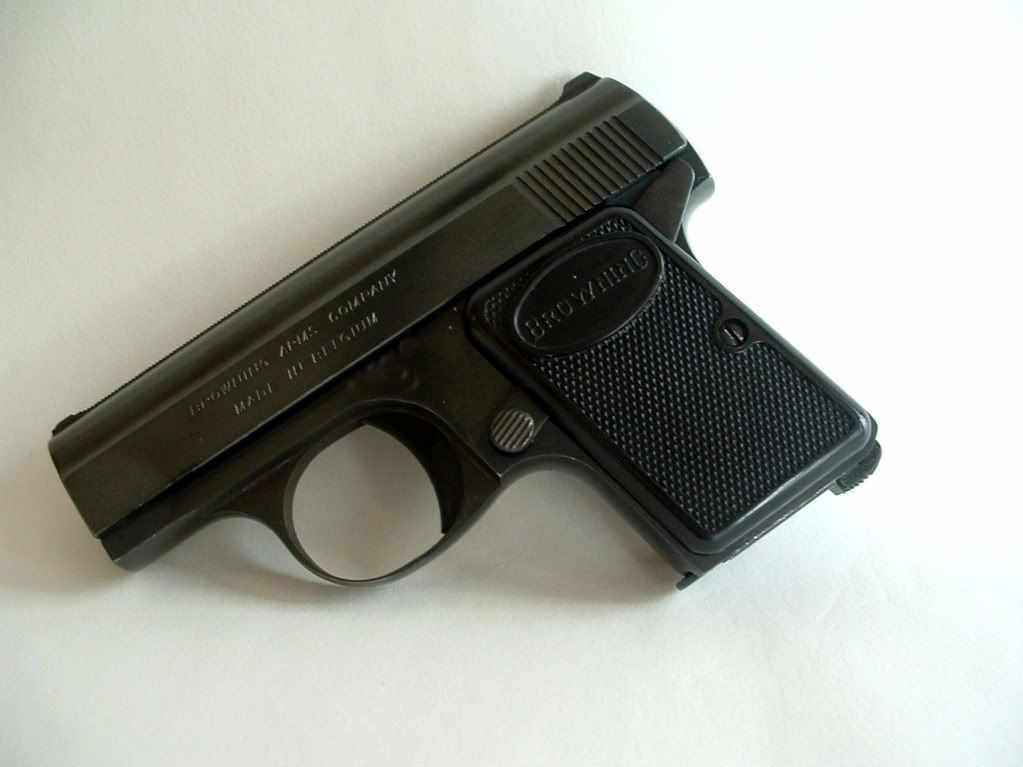When we were at the range, I had the opportunity to run a couple of magazines through a Baby Browning. Truth to tell, I kind of liked it. The little thing shot pretty much to point of aim at 15 feet, and kept all the rounds in a 2" to 3" circle, and for me anyway, experienced no failures to feed, fire, or eject.
Both Breda and her mom had trouble even getting the thing to run - the first problem is the slide requires considerable hand strength to operate, while the pistol itself offers very little area for getting a good hold. The next problem is related - there is only room for one finger on the grip, and unless you really bear down, the gun will shift in your hand dissipating enough of the recoil impulse to result in failure to reliably eject. Finally, making the whole thing worse, is the fact that if you try to hold higher in the frame, (a natural reaction to try to get a more secure grip) the slide will ride back across the top of your hand creating your own little set of railroad tracks.
If "smallest possible" is your goal, you would probably be better served by one the the NAA mini revolvers, but when a dangerous dame gets the drop on Phillip Marlowe this is what she's holding.
"Reach for the sky, shamus."
Update: James Rummel Takes exception to my use of the word failure.
Actually, he is correct, I was writing without thinking, and failure, was not the word I should have used.
What I was trying to convey, albeit clumsily, (hey, it was afternoon at work, and I was in the torpor stage of my day) is that all firearms - all machines actually - consist of a series of trade offs. With hand guns, you are balancing size, weight, capacity, power of cartridge, ease of use, cost, and many other factors.
Hideout pistols trade capacity, and in case of the .25 autos, stopping power, for concealability.
The Baby Browning I shot was a finely crafted pistol - well designed and a pleasure to look at, but I think in this case, too much was traded off for size.
It obviously wasn't a failure commercially, but a gun that you are likely to need "right here, right now" had best be as close to 100 per cent reliable as possible, and the Browning because of its small size (not design flaws) is susceptible to jams caused by improper grip.
It is not fair to compare a pistol designed in the early part of the twentieth century to modern designs, and if I had a chance to buy one at a decent price I would - It's a very cool gun, but I would not carry it for defense.
So, no, the Baby Browning was not a failure, and the dangerous dame from the above would just not be the same holding a Kel-Tec.


4 comments:
"I think it's a case where the design of the gun was so successful that it ultimately failed."
Mike, what are you talking about? "Ultimately failed"?
The gun is still being manufactured by Precision Small Arms. (Although, I must admit, what they offer is way, way overpriced.) The Baby Browning was always a good seller, with troops going into the trenches during WWI first snapping them up to use as a tiny, emergency hideout gun to be used in case they were captured by the enemy.
So the design sells, always sold, and is still being manufactured.
What did you mean by "failed", anyway?
James
Mike,
I do think that the Colt/Browning Vest Pocket from which it was descended was a more shootable design and only a hair bigger.
I think that any troops in the trenches of WWI with a Baby Browning had awesome time-travel machines, since the design wasn't developed from the earlier, bigger FN 1905 Vest Pocket (aka Colt 1908 Vest Pocket) until the 1930s...
"I think that any troops in the trenches of WWI with a Baby Browning had awesome time-travel machines, since the design wasn't developed from the earlier, bigger FN 1905 Vest Pocket (aka Colt 1908 Vest Pocket) until the 1930s..."
And from this source, amongst others....
"The Model 1906 was often popularly referred to as the “Baby Browning,” and when FN later created a new version they officially named it the “Baby Browning” and even put the word “Baby” on some of the early grips."
Seems awfully nitpicky with the vernacular there, Tam, considering what the guys who bought the gun during the Great War called it. No wonder you worked at a gun shop.
James
No, James, you said the pistol in question was carried in the trenches of WWI. It obviously wasn't.
Were you a novice in a gun store, I wouldn't have said a word. I made it a point never to niggle about terminology, my job was to sell guns.
With someone demonstrating expert advice based on their extensive experience on the internets, however, I feel more free to correct misinformation.
(WV: "dreckwas" How appropos."
Post a Comment